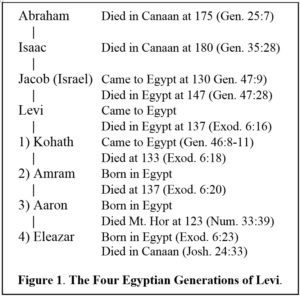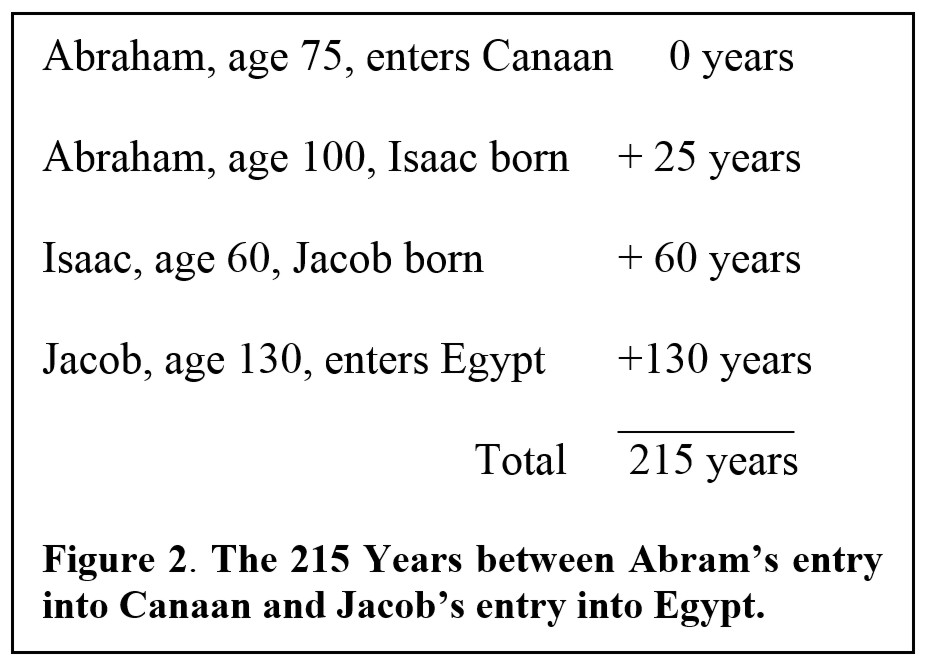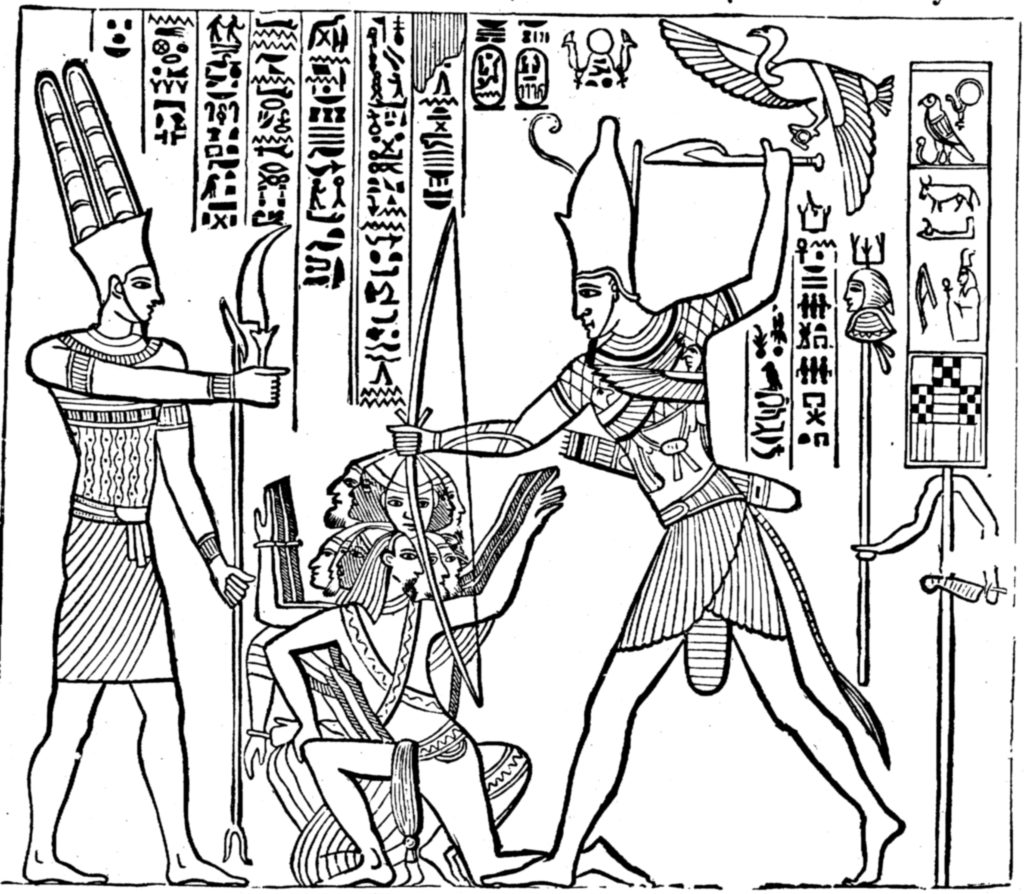How long did the Israelites reside in Egypt? How long were they enslaved? Some commentators have concluded that they were in Egypt 400 or 430 years. A popular movie suggested that they were enslaved for 400 years. However, simple mathematical analysis of the biblical chronology shows that none of these propositions can be true.
I thoroughly explain this issue in my article entitled The Length of the Israelite Sojourn in Egypt, which can be downloaded as a PDF, or read further below on this page. Click HERE to download the PDF.
However, a talented friend, Nathan Hoffman, has done a superb job of encapsulating this issue in a 12-minute video entitled How long were the Israelites in Egypt? Click HERE to view on YouTube.
_____________________________________________
THE LENGTH OF THE ISRAELITE SOJOURN IN EGYPT
Glen A. Fritz, copyright 2016
How long did the Israelites reside in Egypt? Based on the cursory reading of these two scriptures, some commentators have concluded that it was 430 years, or perhaps a round figure of 400 years:
Genesis 15:13. And he [the Lord] said unto Abram, know of a surety that thy seed shall be a stranger in a land [that is] not theirs, and shall serve them; and they shall afflict them four hundred years (KJV, my underlining).
Exodus 12:40-41. Now the sojourning of the children of Israel, who dwelt in Egypt, [was] four hundred and thirty years. And it came to pass at the end of the four hundred and thirty years, even the selfsame day it came to pass, that all the hosts of the LORD went out from the land of Egypt (KJV, my underlining).
The revered Bible Commentator, S. R. Driver, gave this indecisive appraisal:
How long the Israelites had been sojourners in Egypt cannot be determined with certainty… In the Old Testament 400…or 430 years…, and also four generations…are assigned to their period of sojourn there…. The length of the Israelites’ sojourn in Egypt must thus be left an open question (1911, xlv).
Nonetheless, close analysis of these passages, along with other ancient biblical texts and commentaries, indicates that the sojourn in Egypt was 215 years. Although this topic may seem arcane or inconsequential, its clarification is necessary for an accurate biblical chronology, which is needed to develop potential correlations with Egyptian and Near Eastern history.
Explaining Genesis 15:13
Abram was 75 years old when he left Haran for the land of Canaan (Gen. 12:4). Shortly thereafter, a famine forced him to continue on to Egypt. Upon his return to Canaan, he received the divine promises and prophecy recorded in Genesis 15. Here are the verses that concern the sojourn question:
(13) Then the Lord said to him, “Know for certain that your descendants will be strangers in a country not their own, and they will be enslaved and mistreated four hundred years. (14) But I will punish the nation they serve as slaves, and afterward they will come out with great possessions… (16) In the fourth generation your descendants will come back here …” (NIV).
As a point of information, Gen. 15:13 was quoted in the New Testament by Stephen: “God spoke to him [Abraham] in this way: ‘For four hundred years your descendants will be strangers in a country not their own, and they will be enslaved and mistreated’” (Acts 7:6 NIV). Gen. 15:13 and Acts 7:6 list four conditions that Abraham’s offspring would experience within the prophesied 400-year period. They would be: 1) strangers, 2) in land not their own, 3) enslaved, and 4) mistreated.
1) “Strangers.” Abraham, and his son and grandson, Isaac and Jacob, were all strangers in Canaan. Exod. 6:4 states that the Lord established his covenant with Abraham, Isaac, and Jacob, “to give them the land of Canaan, the land of their pilgrimage, wherein they were strangers” (KJV, my italics). Abraham, himself, declared that he was a stranger in Hebron (Gen. 23:4 KJV). Deut. 26:5 instructed the Hebrews to recall that “my ancestor Jacob was a wandering Aramean who went to live as a foreigner in Egypt” (NLT).
The New Testament takes up this idea, saying that Abraham “sojourned in the land of promise, as in a strange country, dwelling in tabernacles [tents] with Isaac and Jacob, the heirs with him of the same promise” (Heb. 11:9 KJV). Abraham, Isaac, and Jacob were strangers in the land because it was promised to their descendants. It technically was not their land because the redemption of that promise did not occur until the close of the Exodus.
2) “In a country not their own.” This phrase does not limit these events to just one “country.” The Hebrew text underlying this verse merely says that the seed of Abraham would be strangers “in land” (b’eretz). This point was addressed by the earliest rabbinical commentary, Seder ‘Olam of the Babylonian Talmud. It noted that the 400 years involved both the Egyptian servitude and the time that Isaac and Jacob were in Canaan (Heinemann 1971).
3) “Enslaved.” Verse 13 cannot mean that all of Abraham’s descendants would be enslaved in Egypt because his son, Isaac, never lived in Egypt. Even when Abraham’s descendants finally went to Egypt, they were not in slavery for 400 years. They prospered while Joseph was in power, and for some time thereafter: “And Joseph died, and all his brethren, and all that generation. And the children of Israel were fruitful, and increased abundantly, and multiplied, and waxed exceeding mighty; and the land was filled with them” (Exod. 1:6-7 KJV).
In explanation, Joseph ruled for 80 years, from age 30 (Gen. 41:46) until his death at 110 (Gen. 50:22). Since the Israelites did not move to Egypt until after the seven plentiful years and the first two years of famine (Gen. 45:6), Joseph would have been about age 39 when their Egyptian sojourn began. Subtracting 39 from 110 leaves at least 71 years of favorable treatment under Joseph’s reign.
4) “Mistreated.” There is some evidence that Abraham’s seed experienced mistreatment outside of Egypt. The Apostle Paul mentioned that Isaac was persecuted (Gal. 4:28-29), perhaps referring to the mocking from Ishmael (Gen. 21:8-9). Later, Isaac was mistreated by the Philistines, with whom he dwelt (Gen. 26:17-22), and perceived himself to have been “hated” by their king, Abimelech. (ibid. 26-27).
In summary, the particulars of Gen. 15:13 dictate that the prophesied 400 years need not, and cannot, apply solely to the events in Egypt.
Calculating the Generations of Genesis 15:16
This verse presents a conundrum for the idea of 430 or 400 years in Egypt by stating that Abraham’s descendants would return to Canaan in the fourth generation. This circumstance would seem to give each generation an improbable 100-year length. In this regard, biblical commentator S. R. Driver (1911, xlv) noted that “the two statements may have been harmonized by the supposition that a ‘generation’ at the period in question consisted of 100 years: but naturally it cannot be done so in reality.”
The lineage of Levi, shown in in Figure 1, is useful for analysis of this verse because he had four generations that lived in Egypt: Kohath, Amram, Aaron, and Eleazar, the latter three being born in Egypt. Because Eleazar died in the “Promised Land” after the Exodus, he would seem to exemplify the fourth generation of Gen. 15:16. Based on this history, the prophetic generation-counting would have begun with the first generation that begot children in Egypt. In Levi’s lineage, that man was Kohath.
Forty years is often cited as the length of a biblical generation. However, greater life spans and evidence of late fatherhood ages at this time in history suggest a longer father-to-son period. For instance, Isaac was 60 when Jacob was born (Gen. 25:26) and Moses was between 40 and 80 when his sons were born in Midian (Exod. 4:20).
Hence, a round figure of 50 years for a generation may be more applicable in this situation. This figure can be tested in the Levi lineage starting with Kohath, who arrived in Egypt with his father (Gen. 46:8-11). Let’s assume that he came as a young child and that 50 years elapsed between his arrival and the birth of his son, Amram. Another 50 years elapsed from Amram to his son Aaron. Likewise, 50 years elapsed between Aaron and his son Eleazar.
Eleazar died in the Promised Land (Josh. 24:33), but his age at death was not given. Let’s suppose that he lived for 20 years in the Promised Land and died at about age 110, as did Joshua (Josh. 24:29) of his same generation. Subtracting these 20 years and the 40-year Exodus from Eleazar’s lifespan, leaves about 50 years for his time in Egypt. Adding the fatherhood ages of Kohath, Amram, and Aaron (50 +50 +50) to Eleazar’s 50 years, calculates to about 200 years. Hence, four 50-year generations would correlate with a theorized 215-year sojourn in Egypt.
A More Precise Calculation for the Egyptian Sojourn
Fortunately, other biblical data are available from which to calculate the time in Egypt. In the New Testament, the Apostle Paul explained that the divine promise made to Abraham was immutable and could not be annulled by the Mosaic Law given 430 years later:
(16) The promises were spoken to Abraham… (17) The law, introduced 430 years later, does not set aside the covenant previously established by God and thus do away with the promise (Gal. 3:16-17 NIV).
Based on Paul’s rabbinical training under Gamaliel (Acts 22:3), his Pharisee pedigree (Phil. 3:5), and his stature as a New Testament author, a great deal of weight must be placed on this statement.
According to Paul, 430 years elapsed between the Abrahamic Covenant of Genesis 15 and the giving of the law at Mount Sinai in the first year of the Exodus. Hence, a portion of the 430 years must apply to events outside of Egypt, namely, the time between Abraham’s entry into Canaan and Jacob’s entry into Egypt. Figure 2 demonstrates how this time mathematically calculates to 215 years.
In explanation, Abraham was 75 when he entered Canaan (Gen. 12:4). He received the Gen. 15 covenant in this time frame, making it year zero in the calculation. Isaac was born 25 years later when Abraham was 100 (Gen. 21:5). Isaac was age 60 when Jacob was born (Gen. 25:26) and Jacob was age 130 when he entered Egypt (Gen. 47:28).
The sum of 25 + 60 + 130 equals 215 years, which was the time between Abraham’s entry into Canaan and the Israelites’ entry into Egypt. Subtracting these 215 years from Paul’s 430 years, leaves 215 years for the sojourn in Egypt.
More Verification of the 215 Years
A number of ancient commentaries support Paul’s 430-year statement, its starting point with Abraham, and the 215-year calculation. For instance, Josephus, the first century AD Jewish historian, recorded that: “they left Egypt…four hundred and thirty years after our forefather Abraham came into Canaan, but two hundred and fifteen years only after Jacob removed into Egypt” (1978, Antiquities II.xv.2).
Earlier, Josephus had referred to the Hebrews being afflicted by the Egyptians for four hundred years (ibid. II.ix.1), mirroring the language of Gen. 15:13. However, this entry seems rather offhanded compared to his later statement in II.xv.2.
The Samaritan Midrash of Memar Marqah, ca AD 300-400, acknowledged the 430-year period and stated that half of this time was spent in Canaan and half in Egypt (Heinemann 1971).
The Book of Jubilees, ca 100 BC (Vanderkam 1989) indicated that 431 years elapsed between Isaac’s birth and the Exodus, based on its reference to the 50-year Jubilee periods of the Jewish calendar (Heinemann 1971). Although Isaac’s birth was 25 years after the promise to Abraham, the general idea echoes the 430 years of Paul and Josephus. Heinemann (ibid. 23) additionally noted “that the author of Jubilees (and, presumably, others at his time) paid no attention to the contradiction between the 430 years and the 400, the latter being, in his view, merely a round figure.”
Eliezer, an 8th-century AD rabbinical scholar, whose work is known as Pirke Rabbi Eliezer, surmised that that the 400 years prophesied to Abraham began when Isaac was born, and that the Israelites were in Egypt for 210 years (Heinemann 1971). Although this concept aligns with the 215 years calculated for Canaan (Figure 2), adding the 25 years between the promise to Abraham and Isaac’s birth would bring the total sojourn only to 425 years, not 430. Still, Eliezer’s idea largely reflected the statement of the Apostle Paul. Similarly, Rashi, the famed 11th-century-AD Jewish scholar, allocated 210 years for the sojourn in Egypt (Ray 2004).
The 430 Years of Exodus 12:40-41
The above observations seem to clash directly with Moses’ statement in Exod. 12:40-41 that the Israelites spent 430 years in Egypt:
(40) Now the sojourning of the children of Israel, who dwelt in Egypt, [was] four hundred and thirty years. (41) And it came to pass at the end of the four hundred and thirty years, even the selfsame day it came to pass, that all the hosts of the LORD went out from the land of Egypt (KJV, my underlining).
Based on the time in Canaan calculated in Figure 2, the simplest explanation would be that the 430 years generally referred to the sojourning of Abraham and his seed. However, the mention of the “children of Israel” in verse 40 would seem to specifically exclude Abraham, Isaac, and Jacob, the latter being the one who was renamed “Israel” in Gen. 32:28. Is there any explanation?
Modern Old Testament translations rely on the Leningrad Codex, a Hebrew Masoretic Text of the Tenakh (Old Testament) dating to the 11th-century AD. Yet, a number of Bible documents that predate the Leningrad Codex diverge from its Exod. 12:40 wording.
The prime example is the Greek Septuagint Bible (abbreviated LXX), which emerged ca 250 BC. “At least two manuscripts of the LXX (LXXBh) and an obelus of the Syro-Hexapla, as well as all known manuscripts of the Samaritan Pentateuch” (Ray 2004), divide the 430 years between Canaan and Egypt. As a point of information, ancient manuscripts used an obelus (†) to denote a spurious or doubtful passage. Pentateuch refers to the first five books of the Bible.
In Ex. 12:40, two Septuagint manuscripts and the Samaritan Pentateuch include the phrase “and Canaan” (Heinemann 1971), giving the reading: “Now the sojourning of the children of Israel, who dwelt in Egypt and Canaan was four hundred and thirty years…” This circumstance is footnoted by the New King James Version (NKJV) and the New International Version (NIV) Bibles. The commonly-used Codex Vaticanus manuscript of the LXX, e.g., Rahlfs (1935) and Brenton (1851), includes this phrase.
There are several ancient versions of Exod. 12:40 that also include the phrase “and their fathers,” which supplies more evidence that some of the 430 years applied to Abraham, Isaac, and Jacob in Canaan. Such works include the Alexandrian Septuagint (Clarke 1832), the Samaritan Pentateuch, the Syro-Hexapla, the Eusebius-Chronicon, and the Armenian, Bohairic, and Ethiopic Bibles (Ray 2004). The addition of these phrases renders Exod. 12:40 as:
Now the sojourning of the children of Israel and their fathers, who dwelt in Egypt and Canaan, was four hundred and thirty years.
Regarding the reliability of the sources for this reading, Bible commentator Adam Clarke (1832) observed that:
The Samaritan Pentateuch is allowed by many learned men to exhibit the most correct copy of the five books of Moses; and the Alexandrian copy of the Septuagint must also be allowed to be one of the most authentic as well as most ancient copies of this version which we possess.
Given these clarifications, the 430 years of Exod. 12:40 is seen to include events in both Canaan and Egypt, which brings it into agreement with the 400-year prophecy of Gen. 15:13 and Paul’s 430 years in Gal. 3:16-17. However, not everyone is convinced. Commentator Paul Ray (2004) acknowledged the weighty scholarly evidence of the Septuagint and the Samaritan Pentateuch. However, he opted for a 430-year Israelite sojourn in Egypt because it would better-correlate with the “historical and archaeological evidence” (ibid.).
Summary
The main chronological issue centers on the reckoning of the starting point for the 400 and 430 years. Did these periods begin with the patriarchs in Canaan or did they begin with the Israelite arrival in Egypt? The answer greatly affects the length of the Egyptian sojourn. Based on the preceding analysis, the Masoretic Text of Exod. 12:40-41 stands alone as the only reference that seems to specify a 430-year Egyptian sojourn.
Conversely, numerous other texts mandate that the 400 and 430 years apply to both Egypt and Canaan. Beginning with Gen. 15:13, it was demonstrated above that the prophesied 400 years cannot solely apply to events in Egypt. Furthermore, the four generations of Gen. 15:16 were shown to favor an Egyptian sojourn length closer to 200 years than 400 years.
The clearest chronological statement was made by the Apostle Paul in Gal. 3:16-17, which specified that the 430 years began with the divine covenant given to Abraham. The biblical chronology of the lives of the Hebrew patriarchs permits a straightforward calculation of 215 years in Canaan. The historian Josephus agreed with this appraisal in Antiquities of the Jews II.xv.2. The Samaritan Midrash of Memar Marqah also split the 430 years between Canaan and Egypt.
The Book of Jubilees expressed a similar concept, listing 431 years between Isaac’s birth and the Exodus. Rabbi Eliezer held that the prophesied 400 years began when Isaac was born, and that the Israelites were in Egypt for 210 years. Similarly, Rashi allocated 210 years for the Egyptian sojourn.
Finally, eight ancient documents point to a corrupted and incomplete Exod. 12:40-41 in the Masoretic Text. These sources include two Septuagint manuscripts, the Samaritan Pentateuch, the Syro-Hexapla, the Eusebius-Chronicon, and the Armenian, Bohairic, and Ethiopic Bibles. Taken as a whole, they supply the idea that “the children of Israel and their fathers dwelt in Egypt and Canaan.” Adding this understanding to the Masoretic Text of Exod. 12:40-41 would bring it into agreement with all of the other cited references.
Hence, the 430 years started with Abraham in his 75th year and ended with the Exodus. This period was split evenly between Canaan and Egypt. The prophesied 400 years began with the birth of his son Isaac and concluded at the Exodus.
Discussion
The above analysis provides the starting points for the 430 and 400-year periods, the former when Abram received the Gen. 15 covenant and the latter, 25 years later at the birth of Isaac. However, it does not reconcile the potential mathematical conflict that exists between them. For instance, the 430 years of Exod. 12:40 and Gal. 3:17 calculates to 215 years in Canaan (Figure 2) and 215 years in Egypt. However, using this reckoning, the 400 years of Gen. 15:13 actually calculates to 405 years, not 400 (subtracting the 25-year gap between the Gen. 15 covenant and Isaac’s birth from the 430 years).
The best explanation is that the 400 years merely represented a round figure, which would put the issue to rest. However, a number of ancient rabbinical sources opted for a 210-year sojourn in Egypt instead of 215 as a way to reduce these 405 years to 400 (see Heinemann 1971). But this adjustment just transfers the problem, shortening the 430 years to 425.
The aforementioned Rabbi Eliezer attempted to harmonize the 210- and 215-year traditions by proffering that Joseph’s two sons, Manasseh and Ephraim, were born five years before the children of Israel entered Egypt, and that these years should be added to the 210 years (Heinemann 1971, 25). However, there is no scriptural basis for the birth dates of Manasseh and Ephraim, or the application of overlapping sojourn years.
Another item of curiosity is the length of the Hebrew enslavement in Egypt. It has already been mentioned that the Hebrews enjoyed at least 71 years of favorable treatment under Joseph—at least until his death at age 110. We also know that the enslavement began at least 80 years before the Exodus because Moses was born during the enslavement and was 80 when the Exodus began. This figure is calculated by subtracting the 40-year Exodus from 120, his age at death (Deut. 34:7). Factoring the 71 and the 80 years into the 215-year sojourn leaves a 64-year window in which the enslavement began. If the start of the slavery is arbitrarily assigned to the midpoint of this period, the Hebrews would have been in bondage for about 112 years. However, this figure is only speculation.
Given the documentary evidence, it seems curious that any informed scholar would still opt to apply the 400 or 430 years entirely to the Egyptian sojourn. The only explanation I can offer is that the Leningrad Codex of the Masoretic Text has been assumed to be infallible.
Conclusion
The Israelite sojourn in Egypt is an important detail of biblical chronology that has been historically associated with confusion. Considering all of the available data, 430 years elapsed between the divine promises to Abraham in Canaan and the start of the Exodus. Half of this time, 215 years, involved the sojourn of Abraham, Isaac, and Jacob (Israel) in Canaan. The other half applied to the Israelite sojourn in Egypt. The prophetic 400 years of Gen. 15, which commenced at Isaac’s birth and concluded at the Exodus, was likely intended as a round figure.
References
Brenton, Sir Lancelot C. L. 1851. The Septuagint with Apocrypha: Greek and English. London: Samuel Bagster, LTD
Clarke, Adam. 1832. “Commentary on Exodus 12:40.” The Adam Clarke Commentary. Available at http://www.studylight.org/commentaries/acc/exodus-12.html.
Driver, S. R. 1911. The Book of Exodus in the Revised Version. Cambridge: Cambridge University Press.
Heinemann, Joseph. 1971. 210 Years of Egyptian Exile. The Journal of Jewish Studies 22(1-4):19-30.
Josephus. 1978. Josephus Complete Works, trans. William Whiston. Grand Rapids, MI: Kregel Publications.
Kitchen, K. A. 1966. Ancient Orient and Old Testament. London: The Tyndale Press.
Ray, Paul J. 2004. The Duration of the Israelite Sojourn in Egypt. Bible and Spade 17(2):33-44. Available at http://www.biblearchaeology.org/post/2012/01/05/The-Duration-of-the-Israelite-Sojourn-In-Egypt.aspx.
Rahlfs, Alfred. 1935. Septuaginta: id est Vetus Testamentum graece iuxta LXX interpretes. Stuttgart: Wurtembergische Bibelanstalt.
Vanderkam, James C., trans. 1989. The Book of Jubilees. Lovanii: Aedibus E. Peters.





